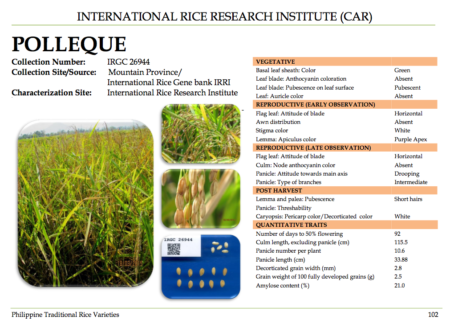- Genetic Nature of Elemental Contents in Wheat Grains and Its Genomic Prediction: Toward the Effective Use of Wheat Landraces from Afghanistan. Only one significant marker, for Zn.
- Strategies for exchange of coconut germplasm in Brazil. Zygotic embryos in Petri dish containing Y3 culture medium without sucrose can last a couple of days without bacterial infection.
- Phylogenetic relationships within Lactuca L. (Asteraceae), including African species, based on chloroplast DNA sequence comparisons. The African species are probably not Lactuca at all.
- The Pacific yam (Dioscorea nummularia Lam.), an under-exploited tuber crop from Melanesia. It can be improved through crossing with itself, or with other species.
- Eco-geographical assessment of Avena L. wild species at the VIR herbarium and genebank collection. Some more collecting to be done.
- The database of the PREDICTS (Projecting Responses of Ecological Diversity In Changing Terrestrial Systems) project. Including 15,000 plants. No word on whether any of them Avena.
- Your Poison in My Pie—the Use of Potato (Solanum tuberosum L.) Leaves in Sakartvelo, Republic of Georgia, Caucasus, and Gollobordo, Eastern Albania. Only used as first vegetable in spring in isolated high mountain areas in the southern Balkans.
- Toward a taxonomic definition of perennial wheat: a new species ×Tritipyrum aaseae described. Not entirely clear why naming it as a new species is necessary, but it’s still pretty cool.
- Dynamics of variety change on wheat farms in Pakistan: A duration analysis. For marginal farmers, it’s about yield, for others, quality. No word on how perennial wheat might do.
Filipino rice landraces documented
Congratulations to all concerned for the launch of the catalogue of Philippine Traditional Rice Varieties. I’m reliably informed it will be available online soon. In the meantime, I’ve had the privilege of consulting a PDF, and I can confirm that it is really as cool as it sounds.

Coconut history 101
Coconut expert Hugh Harries has sent us this comment on the recent article in AramcoWord entitled Cracking Coconut’s History, by Ramin Ganeshram.
Amusingly illustrated and attractively written, in this article Ramin Ganeshram records that in the last few years coconut production, export and processing have become a multibillion-dollar global industry. In fact, coconut was global from the 1860s to the 1960s. It was the leading vegetable oil on international markets for the best part of a century.
Ramin does not mention Polynesians or the Pacific Ocean, but to them the coconut was more than a source of income. It was the life-support system that ensured their extraordinary survival in locations where coconut palms are routinely decimated by hurricanes and tsunamis or simply washed away by rising sea levels.
The article is not quite up to date as a history, even though Ramin refers to the genetic testing underwritten by the National Geographic Society in 2011. This confirmed that today’s cultivated coconut originated in India and Southeast Asia but, surprisingly, claimed it was taken by boat to the Pacific coast of America more than 2,000 years ago. Yet coconuts would not survive since then without cultivation to control weeds and pests or recover from natural disaster.
There is a general consensus coconuts grow very well on coral atolls but an equally general disagreement as to whether they were dispersed to remote islands by floating and were capable of self establishment, or if not, were carried by boat and planted where they could not float.
This is most clearly recognised where they were introduced in Central America and the Caribbean in the mid 16th century. Indian or East African coconuts carried by Portuguese boats into the Atlantic reached Brazil and Puerto Rico by the 1550s. At much the same time, Southeast Asian coconuts were taken by the first Spanish mariners who found the the Manila-Acapulco route in 1565.
It was only when the Panama canal opened 100 years ago that the differences between the two contrasting types were recognised when those from the Pacific coast were imported to Jamaica for replanting areas devastated by hurricanes.
My thanks to Ramin Ganeshram for giving me the opportunity to add some information that I hope will be useful when a revised second edition of this history is prepared.
Nibbles: Agroforestry info, Coffee genome, Citrus family tree, Physalis fossil, Conservation economics, Wild Vicia, African rice history, USDA PGR strategy, Fisheries, Evidence base
- Agroforestry Species Switchboard gets upgrade.
- Arabica sequenzzzzzzz…
- “But what is the point of collecting and preserving this genetic diversity as seed, if it should remain in perpetuity in a seed bank?”
- Citrus untangled.
- 52 million year old tomatillo fossil already had Inflated Calyx Syndrome.
- Faba bean wild relative found, kinda sorta.
- It’s the economics, stupid.
- African rice in the New World. Mash up with peanuts?
- National Program 301: Plant Genetic Resources, Genomics, and Genetic Improvement. Action Plan 2018-2022.
- Communities that catch more diverse fish species are more resilient shock.
- Database of what works in conservation. Not of crop and livestock diversity, though, alas.
Wanna job? Seed Savers Exchange is hiring
One of the foremost public repositories of crop diversity is looking for a new Executive Director. What does the job entail?
The Executive Director is responsible for managing the Seed Savers Exchange’s day-to-day operations, staff, and all budget and fiscal matters. Additionally, the Executive Director will be expected to develop approaches to increase financial support through donations, grants, and membership, develop alliances with like-minded organizations, and increase overall visibility and support for the organization.
Of course you want more details, and we’ve got them, right here. But please, don’t ask us for any more information. We’re only doing this to help SEE find the best possible leader as it moves forward.
One thing I will say. Decorah, Iowa, is a rather nice small town.